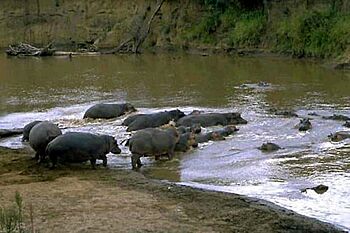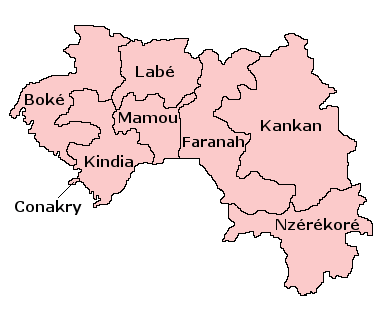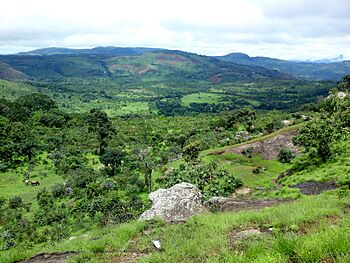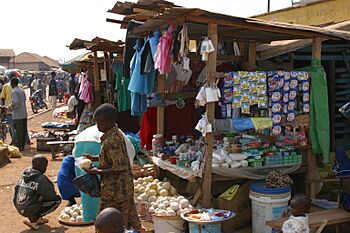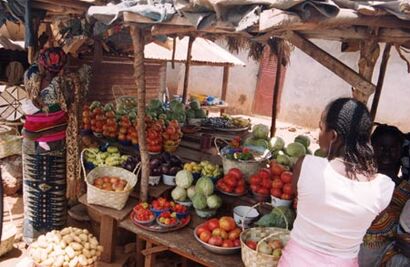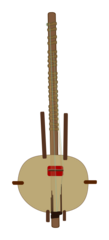Guinea facts for kids
Quick facts for kids
Republic of Guinea
République de Guinée (French)
𞤖𞤢𞤱𞤼𞤢𞥄𞤲𞤣𞤭 𞤘𞤭𞤲𞤫 (hawtaandi Gine) (Pular) ߖߌ߬ߣߍ߫ ߞߊ ߝߊߛߏߖߊߡߊߣߊ (Eastern Maninkakan) |
|
|---|---|
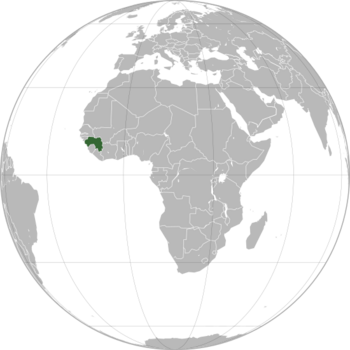
Guinea in dark green
|
|
| Capital and largest city
|
Conakry 9°31′N 13°42′W / 9.517°N 13.700°W |
| Official languages | French |
| Vernacular languages |
|
| Ethnic groups | |
| Demonym(s) | Guinean |
| Government | Unitary presidential republic under a military junta |
|
• Interim President and CNRD Chairman
|
Mamady Doumbouya |
| Bah Oury | |
| Legislature | National Council of the Transition |
| Independence
(was the colony of French Guinea since 1891)
|
|
|
• from France
|
2 October 1958 |
|
• Republic
|
2 October 1958 |
|
• 4th constitution
|
2 October 1958 |
|
• Second Republic Day
|
3 April 1984 |
|
• 2021 Guinean coup d'état
|
5 September 2021 |
| Area | |
|
• Total
|
245,857 km2 (94,926 sq mi) (77th) |
|
• Water (%)
|
negligible |
| Population | |
|
• 2024 estimate
|
13,986,179 (75th) |
|
• Density
|
40.9/km2 (105.9/sq mi) (164th) |
| GDP (PPP) | 2023 estimate |
|
• Total
|
|
|
• Per capita
|
|
| GDP (nominal) | 2023 estimate |
|
• Total
|
|
|
• Per capita
|
|
| Gini (2012) | 33.7 medium |
| HDI (2022) | low · 181st |
| Currency | Guinean franc (GNF) |
| Time zone | UTC (GMT ± 00:00) |
| Date format | dd/mm/yyyy |
| Driving side | right |
| Calling code | +224 |
| ISO 3166 code | GN |
| Internet TLD | .gn |
Guinea, officially the Republic of Guinea, is a coastal country in West Africa. It borders the Atlantic Ocean to the west, Guinea-Bissau to the northwest, Senegal to the north, Mali to the northeast, Côte d'Ivoire to the southeast, and Sierra Leone and Liberia to the south. It is sometimes referred to as Guinea-Conakry, after its capital Conakry, to distinguish it from other territories in the eponymous region, such as Guinea-Bissau and Equatorial Guinea. Guinea has a population of 14 million and an area of 245,857 square kilometres (94,926 sq mi).
Formerly French Guinea, it achieved independence in 1958. Guinea has a history of military coups d'état. After decades of authoritarian rule, it held its first democratic election in 2010.
Muslims represent 90% of the population. The country is divided into four geographic regions: Maritime Guinea on the Atlantic coast, the Fouta Djallon or Middle Guinea highlands, the Upper Guinea savanna region in the northeast, and the Guinée forestière region of tropical forests. French, the official language of Guinea, is a language of communication in schools, government administration, and the media. More than 24 indigenous languages are spoken, and the largest are Susu, Pular, and Maninka, which dominate respectively in Maritime Guinea, Fouta Djallon, and Upper Guinea, while Guinée forestière is ethnolinguistically diverse. Guinea's economy is mostly dependent on agriculture and mineral production. It is the world's second-largest producer of bauxite and has deposits of diamonds and gold. As of the most recent survey in 2018, 66.2% of the population is affected by multidimensional poverty, and an additional 16.4% are vulnerable to it. The country was at the core of the Western African Ebola virus epidemic.
Contents
Name
Guinea is named after the Guinea region which lies along the Gulf of Guinea. It stretches north through the forested tropical regions and ends at the Sahel. The English term Guinea comes directly from the Portuguese word Guiné which emerged in the mid-15th century to refer to the lands inhabited by the Guineus, a generic term for the black African peoples south of the Senegal River, in contrast to the "tawny" Zenaga Berbers above it, whom they called Azengues or Moors.
In 1978, the official name became the People's Revolutionary Republic of Guinea. In 1984, the country was renamed the Republic of Guinea after the death of the first president, Ahmed Sékou Touré.
History
The land that is now Guinea either bordered or was situated within a series of historic African empires before the French arrived in the 1890s and claimed the terrain as part of colonial French West Africa. Guinea declared independence from France on 2 October 1958. From independence until the presidential election of 2010, Guinea was governed by multiple autocratic rulers.
West African empires and kingdoms
What is now Guinea sat on the fringes of various West African empires. The earliest, the Ghana Empire, grew on trade and ultimately fell after repeated incursions of the Almoravids. It was in this period that Islam first arrived in the region by way of North African traders. The Sosso Empire came and stayed from 12th to 13th centuries; later, the Mali Empire came when Soundiata Kéïta defeated the Sosso ruler Soumangourou Kanté at the Battle of Kirina in c. 1235. The Mali Empire was ruled by Mansa (Emperors), including Kankou Moussa, who made a hajj to Mecca in 1324. After his reign, the Mali Empire began to decline and was ultimately supplanted by its vassal states in the 15th century.
The Songhai Empire expanded its power in about 1460. It continued to prosper until a civil war, over succession, followed the death of Askia Daoud in 1582. The empire fell to invaders from Morocco in 1591, but the kingdom later split into smaller kingdoms. After the fall of some of the West African empires, various kingdoms existed in what is now Guinea. Fulani Muslims migrated to Futa Jallon in Central Guinea, and established an Islamic state from 1727 to 1896 with a written constitution and alternate rulers. The Wassoulou or Wassulu Empire (1878–1898) was led by Samori Toure in the predominantly Malinké area of what is now upper Guinea and southwestern Mali (Wassoulou). It moved to Ivory Coast before being conquered by the French.
Colony
European traders competed for the cape trade from the 17th century onward and made inroads earlier. Guinea's colonial period began with French military penetration into the area in the mid-19th century. The defeat of the armies of Samori Touré, Mansa (or Emperor) of the Ouassoulou state and leader of Malinké descent, in 1898 gave France control of what today is Guinea and adjacent areas.
France negotiated Guinea's present boundaries in the late 19th and early 20th centuries with the British for Sierra Leone, the Portuguese for their Guinea colony (now Guinea-Bissau), and Liberia. Under the French, the country formed the Territory of Guinea within French West Africa, administered by a governor general resident in Dakar. Lieutenant governors administered the individual colonies, including Guinea.
In 1958, the French Fourth Republic collapsed due to political instability and its failures in dealing with its colonies, especially Indochina and Algeria. The French Fifth Republic gave the colonies the choice of autonomy in a new French Community or immediate independence in the referendum of 28 September 1958. Guinea voted overwhelmingly for independence. It was led by Ahmed Sékou Touré, whose Democratic Party of Guinea-African Democratic Rally (PDG) had won 56 of 60 seats in the 1957 territorial elections.
The French later withdrew, and on 2 October 1958, Guinea proclaimed itself a sovereign and independent republic, with Sékou Touré as president. Later, Opération Persil was planned by Jacques Foccart; they planned to create large quantities of forged Guinean francs to hyperinflate Guinea's economy and to arm Touré's opposition figures. However, the operation was leaked, and soon, the Guinean was issuing a number of official complaints.
Post-colonial
Under Touré's ruling
In 1960, Touré declared the Democratic Party of Guinea the country's only legal political party, and for the next 24 years, the government and PDG were one. Touré was re-elected unopposed to four 7-year terms as president, and every 5 years voters were presented with a single list of PDG candidates for the National Assembly.
On 22 November 1970, Portuguese forces from neighbouring Portuguese Guinea staged Operation Green Sea, a raid on Conakry by several hundred exiled Guinean opposition forces. Among their goals, the Portuguese military wanted to kill or capture Sekou Touré due to his support of PAIGC, an independence movement and rebel group that had carried out attacks inside Portuguese Guinea from their bases in Guinea. After some fighting, the Portuguese-backed forces retreated. Guinea was elected as a non-permanent member of the UN Security Council 1972–73.
In 1977, a declining economy and a ban on all private economic transactions led to the Market Women's Revolt, a series of anti-government riots started by women working in Conakry's Madina Market. Touré vacillated from supporting the Soviet Union to supporting the United States. The late 1970s and early 1980s saw some economic reforms. After the election of Valéry Giscard d'Estaing as French president, trade increased and the two countries exchanged diplomatic visits.
Under Conté's ruling
Sékou Touré died on 26 March 1984 after a heart operation in the United States, and was replaced by Prime Minister Louis Lansana Beavogui, who was to serve as interim president, pending new elections. PDG was due to elect a new leader on 3 April 1984. Under the constitution, that person would have been the only candidate for president. Hours before that meeting, Colonels Lansana Conté and Diarra Traoré seized power in a bloodless coup. Conté assumed the role of president, with Traoré serving as prime minister, until December.
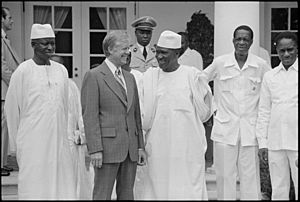
Conté denounced the previous regime's record on human rights, releasing 250 political prisoners and encouraging approximately 200 thousand more to return from exile. He made explicit the turn away from socialism. In 1992, Conté announced a return to civilian rule, with a presidential poll in 1993, followed by elections to parliament in 1995 (in which his party—the Party of Unity and Progress—won 71 of 114 seats). In September 2001, the opposition leader Alpha Condé was imprisoned for endangering state security and pardoned 8 months later. Subsequently, he spent time in exile in France.
In 2001, Conté organized and won a referendum to lengthen the presidential term, and in 2003, began his third term after elections were boycotted by the opposition.
In 2000, Guinea suffered as rebels crossed the borders from Liberia and Sierra Leone. Some thought that the country was headed towards a civil war. Conté blamed neighbouring leaders for coveting Guinea's natural resources, and these claims were denied. In 2003, Guinea agreed to plans with her neighbours to tackle the insurgents. The 2007 Guinean general strike resulted in the appointment of a new prime minister.
Geography
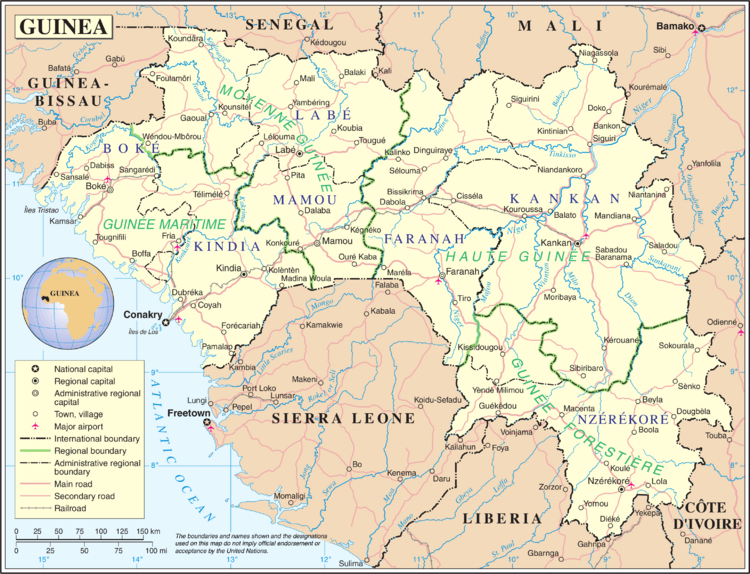
Guinea shares a border with Guinea-Bissau to the northwest, Senegal to the north, Mali to the northeast, Ivory Coast to the east, Sierra Leone to the southwest and Liberia to the south. The nation forms a crescent as it curves from its southeast region to the north and west, to its northwest border with Guinea-Bissau and southwestern coast on the Atlantic Ocean. The sources of the Niger River, the Gambia River, and the Senegal River are all found in the Guinea Highlands. At 245,857 km2 (94,926 sq mi), Guinea is roughly the size of the United Kingdom. There are 320 km (200 mi) of coastline and a total land border of 3,400 km (2,100 mi). It lies mostly between latitudes 7° and 13°N, and longitudes 7° and 15°W, with a smaller area that is west of 15°.
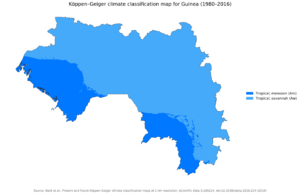
Guinea is divided into 4 regions: Maritime Guinea, also known as Lower Guinea or the Basse-Coté lowlands, populated mainly by the Susu ethnic group; the cooler, more mountainous Fouta Djallon that run roughly north–south through the middle of the country, populated by Fulas; the Sahelian Haute-Guinea to the northeast, populated by Malinké; and the forested jungle regions in the southeast, with several ethnic groups. Guinea's mountains are the source for the Niger, the Gambia, and Senegal Rivers, and rivers flowing to the sea on the west side of the range in Sierra Leone and Ivory Coast. The highest point in Guinea is Mount Nimba at 1,752 m (5,748 ft). While the Guinean and Ivorian sides of the Nimba Massif are a UNESCO Strict Nature Reserve, the portion of the so-called Guinean Backbone continues into Liberia, where it has been mined for decades; the damage is evident in the Nzérékoré Region at 7°32′17″N 8°29′50″W / 7.53806°N 8.49722°W.
Guinea is home to 5 ecoregions: Guinean montane forests, Western Guinean lowland forests, Guinean forest-savanna mosaic, West Sudanian savanna, and Guinean mangroves. It had a 2019 Forest Landscape Integrity Index mean score of 4.9/10, ranking it 114th globally out of 172 countries.
Wildlife
The southern part of Guinea lies within the Guinean Forests of West Africa Biodiversity hotspot, while the north-east is characterized by dry savanna woodlands. Declining populations of some animals are restricted to uninhabited distant parts of parks and reserves.
Species found in Guinea include the following:
- Amphibians : Hemisus guineensis, Phrynobatrachus guineensis
- Reptiles : Acanthodactylus guineensis, Mochlus guineensis
- Arachnids: Malloneta guineensis, Dictyna guineensis
- Insects : Zorotypus guineensis, Euchromia guineensis
- Birds: Melaniparus guineensis
Regions and prefectures
The Republic of Guinea covers 245,857 square kilometres (94,926 sq mi) of West Africa, about 10 degrees north of the equator. It is divided into 4 natural regions:
- Maritime Guinea (La Guinée Maritime) covers 18% of the country.
- Middle Guinea (La Moyenne-Guinée) covers 20% of the country.
- Upper Guinea (La Haute-Guinée) covers 38% of the country.
- Forested Guinea (Guinée forestière) covers 23% of the country, and is both forested and mountainous.
Guinea is divided into 8 administrative regions which are subdivided into 33 prefectures. The capital Conakry with a population of 1,675,069 ranks as a special zone.
| Region | Capital | Population (2014 census by National Institute of Statistics) |
|---|---|---|
| Conakry Region | Conakry | 1,675,069 |
| Nzérékoré Region | Nzérékoré | 1,591,716 |
| Kindia Region | Kindia | 1,573,690 |
| Boké Region | Boké | 1,092,291 |
| Labé Region | Labé | 1,001,392 |
| Mamou Region | Mamou | 737,062 |
| Kankan Region | Kankan | 1,979,038 |
| Faranah Region | Faranah | 949,589 |
Politics
Guinea is a republic. The president is directly elected by the people and is the head of state and the head of government. The unicameral National Assembly is the legislative body of the country, and its members are directly elected by the people. The judicial branch is headed by the Supreme Court of Guinea, the highest and final court of appeal in the country.
The president of Guinea is normally elected by popular vote for a 5-year term; the winning candidate must receive a majority of the votes cast to be elected president. The president governs Guinea, assisted by a council of 25 civilian ministers, appointed by him.
Economy
As of the most recent survey in 2018, 66.2% of the population is affected by multidimensional poverty and an additional 16.4% vulnerable to it.

Agriculture
The agriculture sector at some point employed approximately 75% of the country. The rice is cultivated in the flooded zones between streams and rivers. The local production of rice is not sufficient to feed the country, so rice is imported from Asia. Guinea is one of the emerging regional producers of apples and pears. There are plantations of grapes, pomegranates, and more recent years have seen the development of strawberry plantations, based on the vertical hydroponic system.
Natural resources
Guinea has 25% or more of the world's known bauxite reserves. It has diamonds, gold, and other metals. Bauxite and alumina are the most major exports.
Mining
Guinea possesses over 25 billion tonnes (metric tons) of bauxite—and perhaps up to one half of the world's reserves. Its mineral wealth includes more than 4-billion tonnes of high-grade iron ore, and diamond and gold deposits, and uranium.
Joint venture bauxite mining and alumina operations in north-west Guinea historically provide about 80% of Guinea's Foreign exchange reserves. Bauxite is refined into alumina, which is later smelted into aluminium. The Compagnie des Bauxites de Guinée (CBG) exports about 14 million tonnes of high-grade bauxite annually. CBG is a joint venture, 49% owned by the Guinean government and 51% by an international consortium known as Halco Mining Inc., itself a joint venture controlled by aluminium producer Alcoa (AA), global miner Rio Tinto Group and Dadco Investments. CBG has exclusive rights to bauxite reserves and resources in north-western Guinea, through 2038. In 2008, protesters upset about poor electrical services blocked the tracks CBG uses. Guinea includes a proviso in its agreements with international oil companies, requiring its partners to generate power for nearby communities.
The Compagnie des Bauxites de Kindia (CBK), a joint venture between the government of Guinea and RUSAL, produces some 2.5 million tonnes annually, nearly all of which is exported to Russia and Eastern Europe. Dian Dian, a Guinean/Ukrainian joint bauxite venture, has a projected production rate of 1,000,000 t (1,102,311 short tons; 984,207 long tons) per year, and is not expected to begin operation for several years. The Alumina Compagnie de Guinée (ACG) which took over the former Friguia Consortium produced about 2.4 million tonnes in 2004, as raw material for its alumina refinery. The refinery exports about 750,000 tonnes of alumina. Both Global Alumina and Alcoa-Alcan have signed conventions with the government of Guinea to build large alumina refineries, with a combined capacity of about 4 million tonnes per year.
The Simandou mine is an iron ore reserve. In March 2010, Anglo-Australian corporation Rio Tinto Group and its biggest shareholder, Aluminum Corporation of China Limited (Chinalco), signed a preliminary agreement to develop Rio Tinto's iron ore project. In 2017, the Serious Fraud Office (SFO), Britain's anti-fraud regulator, launched an official investigation into Rio Tinto's business and mining practices in Guinea.
Tigui Camara, a former model, is the first woman in Guinea to own a mining company which is partially run as a social enterprise.
Oil
In 2006, Guinea signed a production sharing agreement with Hyperdynamics Corporation of Houston to explore an offshore tract, and was then in partnership with Dana Petroleum PLC (Aberdeen, United Kingdom). The initial well, the Sabu-1, was scheduled to begin drilling in October 2011, at a site in approximately 700 metres of water. The Sabu-1 targeted a 4-way anticline prospect with upper Cretaceous sands, and was anticipated to be drilled to a total depth of 3,600 meters.
Following the completion of exploratory drilling in 2012, the Sabu-1 well was not deemed commercially viable. In November 2012, Hyperdynamics subsidiary SCS reached an agreement for a sale of 40% of the concession to Tullow Oil, bringing ownership shares in the Guinea offshore tract to 37% Hyperdynamics, 40% Tullow Oil, and 23% Dana Petroleum. Hyperdynamics will have until September 2016, under the current agreement, to begin drilling its next selected site, the Fatala Cenomanian turbidite fan prospect.
Tourism
Among the attractions in Guinea are the waterfalls found mostly in the Basse Guinee (Lower Guinea) and Moyenne Guinee (Middle Guinea) regions. The Soumba cascade at the foot of Mount Kakoulima in Kindia, Voile de la Mariée (Bride's Veil) in Dubreka, the Kinkon cascades that are about 80 m (260 ft) high on the Kokoula River in the prefecture of Pita, the Kambadaga falls that can reach 100 m (330 ft) during the rainy season on the same river, the Ditinn & Mitty waterfalls in Dalaba, and the Fetoré waterfalls and the stone bridge in the region of Labe are among water-related tourist sites.
Sciences and technology
Guinea was ranked 128th out of 132 in the Global Innovation Index in 2023.
Transport
Ahmed Sékou Touré International Airport is the largest airport in the country, with flights to other cities in Africa and to Europe.
Built between 1904 and 1910, a railway once linked Conakry to Kankan via Kouroussa ceased operating in 1995 and had been dismantled altogether by 2007 with rails mostly stolen and/or sold for scrap. Plans had at one time been mooted for the passenger line to be rehabilitated as part of an iron-ore development master plan and while the start of work was announced in 2010, corruption charges led the whole master plan to be paused and the line was rebuilt as a 105 km mineral railway, paralleling the older route as far as the mines of Kalia. There is a state run mineral railway linking the bauxite mines of Sangarédi to the port of Kamsar (137 km) and a 1960s narrow-gauge line operated by Russian aluminium producer RusAl to the mines at Fria (143 km).
As part of the plans to restart iron ore mining at Simandou blocks 1 and 2, the new development consortium pledged in 2019 to fund the construction of a new heavy-duty standard gauge railway to Matakong on the Atlantic coast where they would invest some US$20 billion in developing a deepwater port. The 650 km route is longer than an alternative heading south to the port of Buchanan, Liberia, which was considered as an alternative in an October 2019 feasibility study.
Demography
| Population in Guinea | |||
|---|---|---|---|
| Year | Million | ||
| 1950 | 3.0 | ||
| 2000 | 8.8 | ||
| 2018 | 12.4 | ||
In 2021, the population of Guinea was estimated to be 12.4 million. Conakry, the capital and most populous city, is a hub of economy, commerce, education, and culture. In 2014, the total fertility rate (TFR) of Guinea was estimated at 4.93 children born per woman.
|
Largest cities or towns in Guinea
According to the 2014 census |
||
|---|---|---|
| Rank | Name | Pop. |
| 1 | Conakry | 1,660,973 |
| 2 | Nzérékoré | 195,027 |
| 3 | Kankan | 190,722 |
| 4 | Manéah | 167,354 |
| 5 | Dubréka | 157,017 |
| 6 | Kindia | 138,695 |
| 7 | Siguiri | 127,492 |
| 8 | Kissidougou | 99,931 |
| 9 | Labé | 92,654 |
| 10 | Kamsar | 83,428 |
Many languages are spoken in Guinea. The official language is French. Pular was the native language of 33.9% of the population in 2018, followed by Mandingo with 29.4%. The third most spoken native language is the Susu, spoken by 21.2% of the population in 2018 as their first language. The remainder of the population has other native languages, including Kissi and Kpelle.
The population of Guinea comprises about 24 ethnic groups. The Mandinka, also known as Mandingo or Malinké, comprise 29.4% of the population and are mostly found in eastern Guinea, concentrated around the Kankan and Kissidougou prefectures. The Fulas or Fulani comprise 33.4% of the population and are mostly found in the Futa Djallon region. The Soussou, comprising 21.2% of the population, are predominantly in western areas around the capital Conakry, Forécariah, and Kindia. Smaller ethnic groups make up the remaining 16% of the population, including Kpelle, Kissi, Zialo, Toma and others. In 2017, approximately 10,000 non-Africans lived in Guinea, predominantly Lebanese, French, and other Europeans.
Religion
| Guinea religious groups in 2020 | ||||
|---|---|---|---|---|
| Religion | Per cent | |||
| Islam | 86.8% | |||
| Traditional African religion | 9.42% | |||
| Christianity | 3.52% | |||
In 2023, the Association of Religion Data Archives (ARDA) noted that the population was made up of Muslims at 86.8%, Christian 3.52%, and Animist 9.42%. In the past Muslims and Christians have incorporated indigenous African beliefs into their outlook.
The majority of Guinean Muslims are adherent to Sunni Islam, of the Maliki school of jurisprudence, influenced by Sufism. Christian groups include Roman Catholics, Anglicans, Baptists, Seventh-day Adventists, and Evangelical groups. Jehovah's Witnesses are active in the country and recognized by the Government. There is a Baháʼí Faith community. There are numbers of Hindus, Buddhists, and traditional Chinese religious groups among the expatriate community.
Education
In 2010, it was estimated that 41% of adults were literate (52% of males and 30% of females). Primary education is compulsory for 6 years. In 1999, primary school attendance was 40% and children, particularly girls, were kept out of school to assist their parents with domestic work or agriculture or to be married. In 2015, Guinea had "one of the highest rates" of child marriage in the world.
Culture
Sports
Football is the "most popular sport" in the country of Guinea, alongside basketball. Football operations are run by the Guinean Football Federation. The association administers the national football team, and the national league. It was founded in 1960 and affiliated with FIFA since 1962 and with the Confederation of African Football since 1963. The Guinea national football team, nicknamed Syli nationale (National Elephants), have played international football since 1962. Their first opponent was East Germany. They have yet to reach World Cup finals, and were runners-up to Morocco in the Africa Cup of Nations in 1976.
Guinée Championnat National is the top division of Guinean football. Since it was established in 1965, 3 teams have dominated in winning the Guinée Coupe Nationale. Horoya AC has at least 16 titles and is the 2017–2018 champion. Hafia FC (known as Conakry II in 1960s) has at least 15 titles, having dominated in 1960s and 70s. AS Kaloum Star (known as Conakry I in the 1960s) has at least 13 titles. All 3 teams are based in Conakry. Hafia FC won the African Cup of Champions Clubs 3 times, in 1972, 1975 and 1977, while Horoya AC won the 1978 African Cup Winners' Cup.
Cuisine
Guinean cuisine varies by region with rice as a staple. Cassava is consumed. Part of West African cuisine, the foods of Guinea include yétissé, peanut sauce, okra sauce and tapalapa bread. In rural areas, food is eaten from a "large serving dish" and eaten by hand outside of homes.
Music
The traditional instruments of Guinea are the drum, kora, bala and koni.
See also
 In Spanish: Guinea para niños
In Spanish: Guinea para niños





